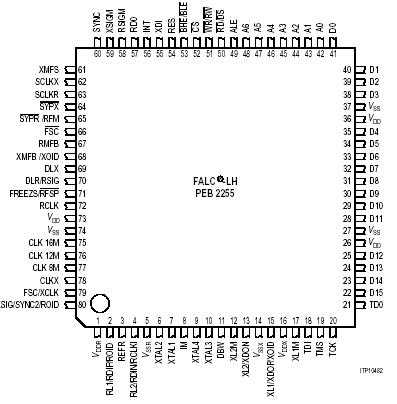Features: Line Interface
• High density, generic interface for all E1/T1/J1 applications
• Analog receive and transmit circuitry for long haul and short haul applications
• Data and clock recovery using an integrated digital phase locked loop
• Maximum line attenuation up to -43 dB at 1024 kHz (E1) and up to -36 dB at 772 kHz (T1/J1)
• Programmable transmit pulse shapes for E1 and T1/J1 pulse masks
• Programmable line build-out for CSU signals according to ANSI T1.403 + FCC68 in steps of 0 dB, -7.5 dB, -15 dB and -22.5 dB (T1/J1)
• Low transmitter output impedances for high transmit return loss
• Tristate function of the analog transmit line outputs
• Transmit line monitor protecting the device from damage
• Jitter specifications of ITU-T I.431, G.703, G.736 (E1), G.823 (E1) and AT&T TR62411 (T1/J1) are met
• Optional crystal-less wander and jitter attenuation/compensation
• Dual rail or single rail digital inputs and outputs
• Unipolar NRZ or CMI coding for interfacing fibre optical transmission routes
• Selectable line codes (E1: HDB3, AMI - T1/J1: B8ZS, AMI with ZCS) for analog interface
• Loss of signal indication with programmable thresholds according to ITU-T G.775 and ETS300233 (E1)/ANSI T1.403, T1.231(T1/J1)
• Clock generator for jitter free system/transmit clocks
• Local loop and remote loop for diagnostic purposes
• Only one type of transformer (ratio 1:2) for E1 75/120 Ω and T1/J1 100/110 Ω P-MQFP-80-1
Frame Aligner
• Frame alignment/synthesis for 2048 kbit/s according to ITU-T G.704 (E1) and for
1544 kbit/s according to ITU-T G.704 and JT G.704 (T1/J1)
• Programmable frame formats :
E1: Doubleframe, CRC Multiframe (E1)
T1: 4-Frame Multiframe (F4,FT), 12-Frame Multiframe (F12, D3/4), Extended
Superframe (F24, ESF), Remote Switch Mode (F72, SLC96)
• Selectable conditions for recover/loss of frame alignment
• CRC4 to non-CRC4 interworking of ITU-T G. 706 Annex B (E1)
• Error checking via CRC4 procedures according to ITU-T G. 706 (E1)
• Error checking via CRC6 procedures according to ITU-T G. 706 and JT G.706 (T1/J1)
• Performs synchronization in ESF format according to NTT requirements (J1)
• Alarm and performance monitoring per second 16 bit counter for CRC-, framing errors, code violations, error monitoring via E bit and SA6 bit (E1), errored blocks, PRBS bit errors
• Insertion and extraction of alarm indication signals (AIS, Remote⁄Yellow Alarm, AUXP)
• IDLE code insertion for selectable channels
• 8.192 MHz/2.048 MHz (E1) or 8.192 MHz/1.544 MHz (T1/J1) system clock frequency
• Selectable 2048/4096 kbit/s backplane interface with programmable receive/transmit timeslot offset
• Programmable tristate function of 4096 kbit/s output via RDO
• Elastic store for receive and transmit route clock wander and jitter compensation; controlled slip capability and slip indication
• Programmable elastic buffer size: 2 frames/1 frame/short buffer/bypass
• Supports fractional E1 or T1 access
• Flexible transparent modes
• Programmable In-Band Loop Code detection and generation (TR62411)
• Channel loop back, line loop back or payload loop back capabilities (TR54016)
• Pseudo random bit sequence (PRBS) generator and monitor
• Provides loop-timed mode
• Clear channel capabilities (T1/J1)
Signaling Controller
• HDLC controller
Bit stuffing, CRC check and generation, flag generation, flag and address recognition,
handling of bit oriented functions, programmable preamble
• DL-channel protocol for ESF format according to ANSI T1.403 or according to AT&T
TR54016 (T1/J1)
• DL-channel protocol for F72 (SLC96) format
• CAS controller with last look capability, enhanced CAS- register access and freeze signaling indication
• Robbed bit signaling capability (T1/J1)
• Provides access to serial signaling data streams
• CAS Multiframe synchronization and synthesis according to ITU-T G.732
• Alarm insertion and detection (AIS and LOS in Timeslot 16)
• Transparent mode
• FIFO buffers (64 bytes deep) for efficient transfer of data packets.
• Time-slot assignment
Any combination of time slots selectable for data transfer independent of signaling
mode
Microprocessor Interface
• 8/16 bit microprocessor bus interface (Intel or Motorola type)
• All registers directly accessible (byte or word access)
• Multiplexed and non-multiplexed address bus operations
• Extended interrupt capabilities
• Hardware and software reset
• One second timer
General
• Boundary scan standard IEEE 1149.1
• P-MQFP-80 package; body size 14x14; pitch 0.65
• 5V power supply
• Typical power consumption 450 mW
Application• Wireless Basestations
• E1/T1/J1 ATM Gateways, Multiplexer
• E1/T1/J1 Channel & Data Service Units (CSU, DSU)
• E1/T1/J1 Internet Access Equipment
• LAN/WAN Router
• ISDN PRI, PABX
• Digital Access Cross Connect Systems (DACS)
• SONET/SDH Add/Drop MultiplexerPinout

 PEB255 Data Sheet
PEB255 Data Sheet








